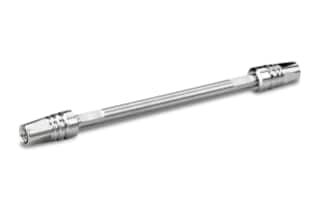
|
Chemistry |
C18 |
|
Separation Mode |
Reversed Phase |
|
Particle Substrate |
Hybrid |
|
pH Range Min |
1 pH |
|
pH Range Max |
11 pH |
|
Maximum Pressure |
18000 psi (1240 Bar) |
|
Endcapped |
Yes |
|
Silanol Activity |
Low |
|
Particle Shape |
Spherical |
|
Particle Size |
1.7 µm |
|
Endfitting Type |
Parker-style |
|
Pore Size |
130 Å |
|
Format |
Column |
|
Surface Area |
185 |
|
System |
UPLC, UHPLC |
|
Particle Technology |
CSH |
|
USP Classification |
L1 |
|
Inner Diameter |
1 mm |
|
Length |
100 mm |
|
Carbon Load |
15 % |
|
eCord |
Yes |
|
UNSPSC |
41115709 |
|
Brand |
ACQUITY UPLC |
|
Product Type |
Columns |
|
Units per Package |
1 pk |

ACQUITY UPLC CSH C18 Column, 130Å, 1.7 µm, 1 mm X 100 mm, 1/pk
The ACQUITY UPLC CSH C18 Column is based on Charged Surface Hybrid (CSH) Technology, which allows for low-level surface charge to give better selectivity and outstanding peak shape in low-ionic-strength mobile phases. The CSH technology aids the ACQUITY UPLC CSH C18 Column in providing remarkable peak shape and loading capacity, especially for basic chemicals in low-pH and weak ionic strength mobile phase conditions.
The ACQUITY UPLC CSH C18 Column was created with a worldwide marketplace in mind, so you may get the same repeatable procedures and results regardless of where your team(s) and labs are located. It provides methods that are easily transportable and reliable.
The CSH technology employed in the ACQUITY UPLC CSH C18 Column gives TFA (Trifluoroacetic acid) peak shape performance without actually utilizing TFA. As a result, it avoids the drawbacks of TFA while providing outstanding outcomes. A more MS-friendly mobile phase, such as formic acid, results in improved peak performance. Furthermore, because formic acid does not have the lingering chromatographic effects of an ion-pairing agent, the ACQUITY UPLC CSH C18 Column will allow for faster and easier method development.
You will be able to see gains in resolution, sensitivity, and analysis speed while using UPLC Technology. If your priority is ultra-fast analysis, enhanced throughput while keeping resolution, improving sample resolution while decreasing analysis time, or obtaining ultra-high resolution in your results, the ACQUITY UPLC CSH C18 Column will give you the freedom to execute a variety of tests.
You can visit our website or refer to our catalog to locate products that work with your setup or to shop for lab equipment to replace your stock and expand your existing equipment portfolio as needed. You can use our website to also reach out to a member of our global client support team if you have any questions, concerns, or need guidance in product information and selection. We also recommend the ACQUITY UPLC CSH C18 VanGuard Pre-column, 130Å, 1.7 µm, 2.1 mm X 5 mm, 3/pk; this VanGuard pre-column connects directly to the intake of the ACQUITY UPLC column, reducing excessive column volumes and leaking by eliminating additional connections.
What Is The Maximum Pressure That The ACQUITY UPLC CSH C18 Column Can Withstand?
Although the ACQUITY UPLC CSH C18 Column can withstand working pressures up to 18000 psi (or 1240 Bar), we do not recommend exposing the column to extreme pressures, pH, or temperatures for lengthy periods of time since this will result in shorter column lives.